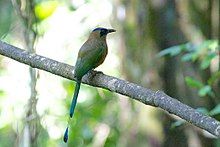| Whooping motmot | |
|---|---|

| |
| Conservation status | |
 Least Concern (IUCN 3.1) | |
| Scientific classification | |
| Domain: | Eukaryota |
| Kingdom: | Animalia |
| Phylum: | Chordata |
| Class: | Aves |
| Order: | Coraciiformes |
| Family: | Momotidae |
| Genus: | Momotus |
| Species: | M. subrufescens |
| Binomial name | |
| Momotus subrufescens Sclater, PL, 1853 | |

| |
The whooping motmot (Momotus subrufescens) is a colorful near-passerine bird in the family Momotidae. It is found in Colombia, Ecuador, Panama, Peru, and Venezuela.
Taxonomy and systematics
The whooping motmot and the blue-capped (Momotus coeruleiceps), Trinidad (M. bahamensis), Amazonian (M. momota), Lesson's (M. lessonii), and Andean motmots (M. aequatorialis) were at one time all considered conspecific. They were split following a 2009 publication which detailed their differences. The whooping motmot has four recognized subspecies, the nominate Momotus subrufescens subrufescens, M. s. spatha, M. s. osgoodi, and M. s. agenticinctus.
Description
The whooping motmot's back and wings are olive-green and the underparts dull brown. It has a long, green to blue, tail that has extended feathers with racquet tips that are blue tipped with black. Its crown is black surrounded by a blue band, and it has a black eyemask bordered with turquoise. Twenty-seven specimens of the nominate whooping motmot weighed 75 to 124 g (2.6 to 4.4 oz).
Distribution and habitat
The whooping motmot has two disjunct populations. The nominate subspecies is found from eastern Panama to northern and western Colombia. M. s. spatha is only on the Guajira Peninsula of northern Colombia. M. s. osgoodi is found from eastern Colombia into northwestern Venezuela. M. s. agenticinctus is separate; it is found in western Ecuador and northwestern Peru. The whooping motmot inhabits several forest types including lowland evergreen and deciduous primary forests, forest edges, and secondary forest.
Behavior
Feeding
Not much is known about the whooping motmot's diet. It probably mostly eats large arthropods but is also reported to eat berries and lizards.
Breeding
Like most Coraciiformes, the whooping motmot nests in long tunnels in earth banks.
Vocalization
The whooping motmot's song has been described as "whoooop" and a shorter "whoop" .
Status
The IUCN has assessed the whooping motmot as being of Least Concern.
References
- ^ BirdLife International (2020). "Momotus subrufescens". IUCN Red List of Threatened Species. 2020: e.T61634657A163628473. doi:10.2305/IUCN.UK.2020-3.RLTS.T61634657A163628473.en. Retrieved 7 October 2023.
- ^ Gill, F.; Donsker, D.; Rasmussen, P. (January 2021). "IOC World Bird List (v 11.1)". Retrieved January 14, 2021.
- Remsen, J. V., Jr., J. I. Areta, E. Bonaccorso, S. Claramunt, A. Jaramillo, D. F. Lane, J. F. Pacheco, M. B. Robbins, F. G. Stiles, and K. J. Zimmer. Version 19 January 2021. A classification of the bird species of South America. American Ornithological Society. https://www.museum.lsu.edu/~Remsen/SACCBaseline.htm retrieved January 19, 2021
- ^ Orzechowski, S. C. and T. S. Schulenberg (2020). Whooping Motmot (Momotus subrufescens), version 1.0. In Birds of the World (T. S. Schulenberg, Editor). Cornell Lab of Ornithology, Ithaca, NY, USA. https://doi.org/10.2173/bow.bucmot3.01 retrieved May 5, 2021
- Stiles, F. Gary (2009). "A review of the genus Momotus (Coraciiformes:Momotidae) in Northern South America and adjacent areas" (PDF). Ornitología Colombiana. 8: 29–75. ISSN 1794-0915. Retrieved May 5, 2021.